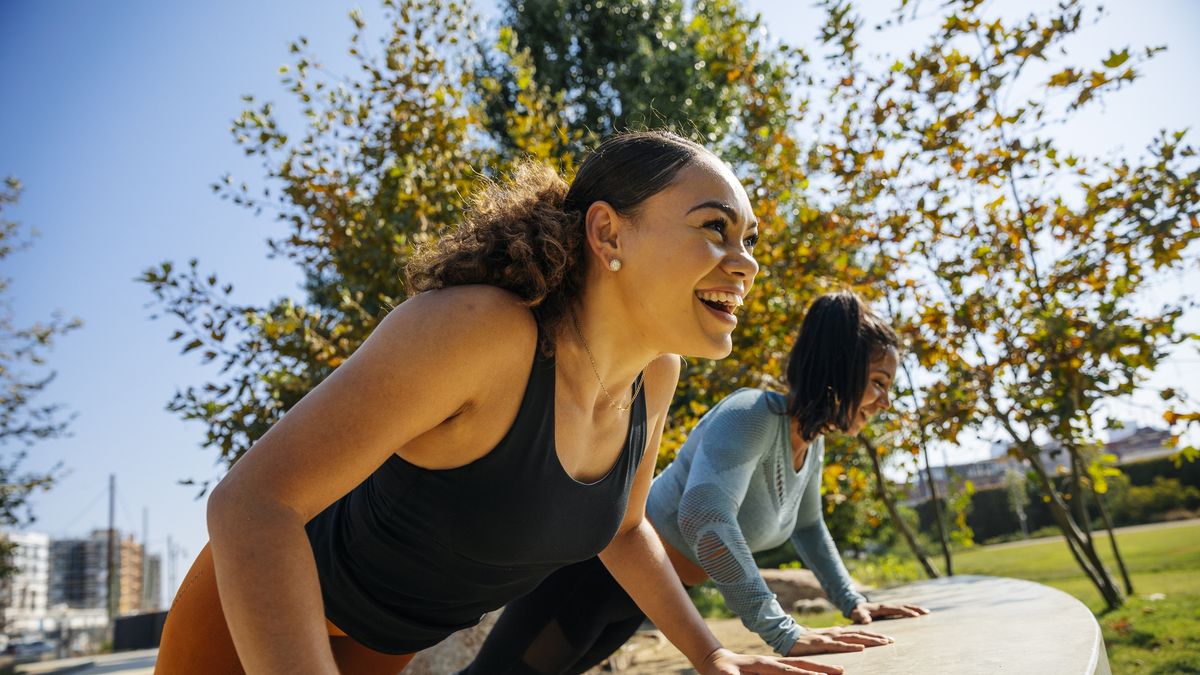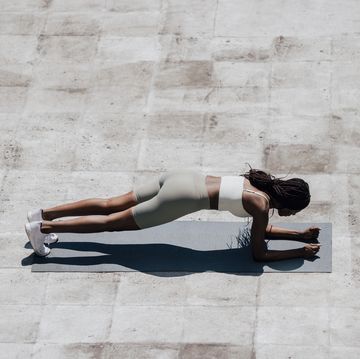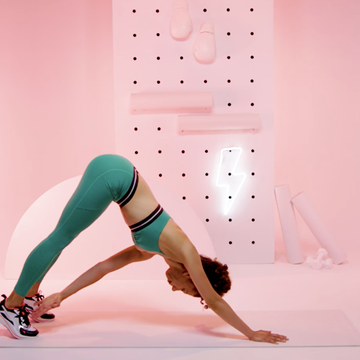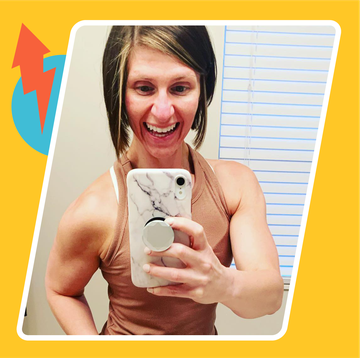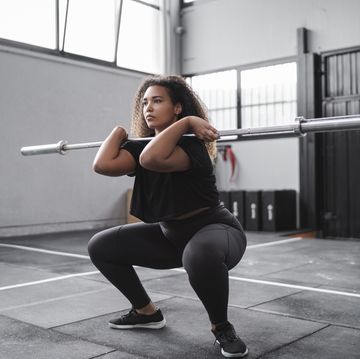You may want to incorporate full pushups into your workouts, but TBH, they’re pretty hard to do. And they're even harder to do the right way. While a pushup may look pretty simple, doing full pushups (a.k.a., from the toes) are a total feat of strength, and they're a particularly tough move for those who haven’t built up their upper-body muscles yet. They're also common in workout classes and HIIT circuits, so it's understandable to want to nail your goal of a full pushup.
“Many women automatically think they can’t do them or that they have to do them from the knees,” explains Kristen Hislop, CPT, head coach at Hislop Training. But Hislop and other trainers are here to tell you that’s not the case! You can learn to do a pushup from your toes with proper training, primarily through progressive exercises that acclimate your body to new movements and strengthen the arms, shoulders, core, and back.
Meet the experts: Kristen Hislop, CPT, head coach at Hislop Training. Rachel Trotta, CPT, with with specializations in women’s fitness, pre/postnatal, nutrition, and therapeutic exercise. Maya Evans, CPT, a certified personal trainer and House of Athlete coach. Rachel MacPherson, CPT and Certified Exercise Nutritionist.
Not sure where to start? Below, find four of the best tips from certified personal trainers, all of which include exercises, step-by-step advice, and workout inspiration to help you perfect a full pushup from your toes in no time at all. Advice before you get started, from Rachel Trotta, CPT:
- Do these movements at the beginning of workouts, shortly after your warmup. They require good form, so it’s smart to tackle them before you get too fatigued.
- Take recovery days between each pushup session. The rotator cuff can be easily stressed. (Especially if you’re still working out kinks with your form.) Spacing out your workouts allows you to bounce back stronger.
- Don’t do these exercises to failure if they’re challenging for you. Always leave some reps (and gas) in the tank, so that you can do every rep with good form.
Now, it’s time to dive into the specifics. Buckle up and get ready to rip out some reps.
1. Start by perfecting your high plank.
When you can’t do a tricky move or exercise right off the bat, Hislop recommends trying regressions of that move first. For example, the foundation of a pushup is a high plank. This means that to do the perfect pushup, you first need to hold a plank well and confidently, Hislop says.
“It is important to be able to hold a plank before you add motion,” she says, otherwise you may risk injury to your back, arms, or shoulders.
Here’s what your plank should look like:
- Your hands should be stacked beneath your shoulders with fingers spread on the floor facing forward. Your elbows should point back.
- You are on your toes and can draw a line from your head through your shoulders and hips to your feet.
- Your glutes and hamstring are engaged, your pelvis is tucked, and your head and neck are neutral.
- Stay in the plank for 20 to 30 seconds, then take a 1- to 2-minute rest. You can start by doing 3 to 4 reps like this.
- As you improve over the weeks, you can increase your time spent consecutively in the plank position, and decrease the reps.
2. Work your back and shoulders with scapular pushups.
Pushups are all about working with your upper body—and this next exercise does just that. Say hello to scapular pushups.
“This surprisingly challenging modification requires you to build awareness of your upper back position and movement, which is critical for successful push-ups,” Trotta explains. The key to scapular pushups is keeping your arms straight at the elbows, your head still, and your lower back neutral. (You don’t want the movement to “creep into other areas, but instead keep it focused on the scapulae,” Trotta says).
Here’s how to do scapular pushups:
- Start in a plank position, with your shoulders stacked directly over your hands.
- Engage your core and glutes, inhale, and squeeze your shoulder blades (scapulae) down and together in your upper back.
- Exhale and separate your scapulae again, with your back moving upward to the starting position.
- Try doing 10 to 15 reps for two to three sets.
3. Incline pushups will give you handy support.
Practicing easier pushup variations will help you get closer to the real thing. Another popular variation is any type of incline pushup, which takes the pressure off your wrists.
“In your starting position, the closer that your chest is to being parallel to the ground, the harder it is,” says Maya Evans, CPT, House of Athlete coach. “If you can’t do a standard pushup, then increase the incline." You can also do these on a workout bench, table, secure chair, couch, even a wall—anything that gives you a stable, elevated incline surface to push off from.
Here's how to do incline pushups:
- Stand arm’s length from a chair, wall, bench, or whatever elevated surface you choose. Place both palms on the elevated surface and slightly wider than shoulder-width apart. Place feet hip-width apart.
- Bend your elbows close to the body as you lower to the surface.
- Once your forehead is close to the surface, push back up.
- Complete 5 reps, if possible. That’s one set. Complete two to three sets total.
4. Work on completing pause pushups to get stronger.
The most difficult part of completing a full pushup isn’t the “going down” motion, but having the strength to move the body back to the starting position. For this reason, try pause pushups, recommends Rachel MacPherson, CPT, who is also a certified exercise nutritionist. (Some trainers also call these hand-release pushups or eccentric pushups.)
“In this exercise you lower as you would a normal push up, then rest on the floor before attempting to push yourself up,” MacPherson explains. If you can’t push yourself back up, that’s fine, just reset at the top until you build up enough strength to do so over time.
Here’s how to do pause pushups:
- Get on the floor in a plank position. Place your hands a little wider than a typical plank positioning, aligned with your chest.
- Brace your core and squeeze your glutes. Don't allow your back to arch or cave downward.
- Bend your elbows to lower yourself to the floor completely.
- Pause on the floor with your hands beside your chest. Rest for a beat.
- Then, push up if you can. If not, use your knees to raise up and get back into the starting position.
- Complete 5 reps, if possible. That’s one set. Complete two to three sets total.
And with that, you're off to the races. These experts know what they're talking about, so it's time to stop scrolling and try out some of these prep moves. Trust me, you'll be challenging your siblings and partners to pushup contests in no time at all.
Madeline Howard is a writer, editor, and creative based in Brooklyn. Her work has been published in Esquire, Nylon, Cosmopolitan, and other publications. Among other things, she was formerly an editor at Women’s Health. Subscribe to her newsletter ‘hey howie’ at madelinehoward.substack.com.
